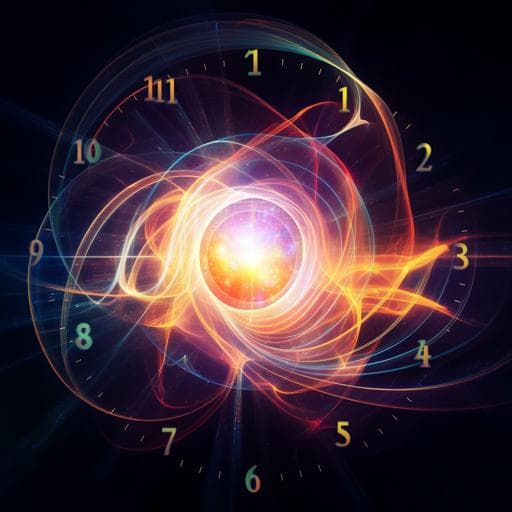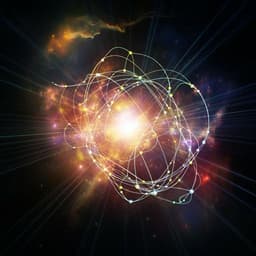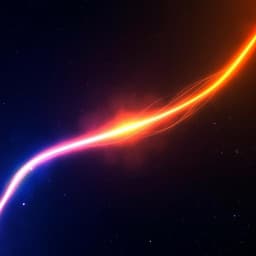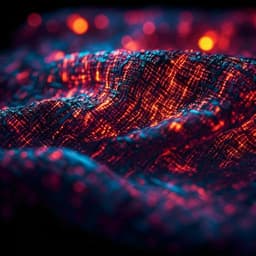
Physics
Room-temperature single-photon source with near-millisecond built-in memory
K. B. Dideriksen, R. Schmieg, et al.
This groundbreaking research, conducted by Karsten B. Dideriksen, Rebecca Schmieg, Michael Zugenmaier, and Eugene S. Polzik, unveils a room-temperature single-photon source with a remarkable near-millisecond memory, far surpassing existing systems. Dive into the potential of quantum storage as single photons remain perfectly correlated for an astonishing 0.68 ms!
~3 min • Beginner • English
Introduction
Deterministic solid-state single-photon sources have achieved excellent performance but typically require cryogenic temperatures for high-visibility interference. Ultracold atomic systems also achieve strong performance but at the cost of experimental complexity. Room-temperature atomic vapors provide a promising alternative due to scalability, robustness, and compatibility with atomic memories, and align with the DLCZ framework that unifies photon generation and storage in ensembles. For quantum networking over continental scales, sources must support on-demand generation within storage times on the millisecond scale to match photon time-of-flight. Prior room-temperature DLCZ-type implementations have been limited to microsecond-scale on-demand retrieval, primarily due to thermal motion, collisional decoherence, and readout noise such as four-wave mixing (FWM). The research question addressed here is whether a room-temperature atomic ensemble can serve as a deterministic single-photon source with near-millisecond storage while preserving non-classical correlations and single-photon purity. The study demonstrates such a source by combining motional averaging, a spin-preserving wall coating, and a magic detuning for Raman readout to suppress FWM.
Literature Review
The work builds on several strands of literature: (i) solid-state single-photon emitters and atom-cavity systems achieving high indistinguishability but often requiring cryogenic operation; (ii) ensemble-based quantum repeaters and DLCZ-type protocols combining single-photon generation and storage; (iii) room-temperature quantum memories demonstrating storage of weak classical pulses for microseconds to milliseconds, including second-scale storage of classical light; and (iv) strategies to suppress four-wave mixing noise in warm vapors (e.g., ladder schemes, cavity engineering, absorption-based methods, Raman absorption, and polarization selection rules). Prior room-temperature DLCZ-like photon sources were constrained to microsecond storage due to thermal motion and collisional decoherence, with FWM identified as a dominant noise source that degrades readout purity. Motional averaging has been proposed to project excitations into symmetric Dicke modes mitigating motion-induced dephasing, and spin-preserving wall coatings extend coherence by protecting Zeeman populations through many wall collisions.
Methodology
- System: A thermal cesium vapor cell (interaction volume 300 µm × 300 µm × 10 mm) with a spin-preserving alkane anti-relaxation coating is placed in an asymmetric linear cavity (finesse ≈ 13; mode waist ≈ 90 µm). The experiment operates at ≈ 43 °C with a magnetic field yielding a Zeeman splitting ν_Z ≈ 2.4 MHz. Ground-state Zeeman coherence time measured via magneto-optical resonance is T2 ≈ 2 ms.
- State preparation: Atoms are optically pumped into |g⟩ = |F = 4, m_F = 4⟩ with polarization >99.2% using circularly polarized pump/repump beams (pump: F = 4 → 4; repump: F = 3 → 2,3 crossover). Optimized timing turns off repump first then keeps pump on briefly to maximize polarization.
- Write (heralding) process and motional averaging: A far-detuned, π-polarized write pulse drives spontaneous Raman scattering, and detection of an orthogonally polarized write photon heralds creation of a single collective spin excitation in |s_i⟩ = |F = 4, m_F = 3⟩, projecting the ensemble onto the symmetric Dicke state. Motional averaging is implemented by narrowband filter cavities that add random delays exceeding the transverse transit time, erasing which-path information and equalizing contributions of all atoms. Polarization filtering (Glan-Thompson polarizer with quarter/half-wave plates) achieves ≈ 5 × 10^−5 leakage; spectral filtering via two cavities provides ≈ 60 dB suppression and implements motional averaging. Heralding probability into the symmetric mode is ≈ 82%.
- Read (retrieval) process and FWM suppression: A linearly polarized read pulse retrieves the stored excitation via Raman scattering into the desired polarization mode. To suppress undesired read-induced FWM that would create excess excitations, the read laser is tuned to a magic detuning Δ ≈ 924 MHz, exploiting destructive interference among Raman amplitudes via multiple excited states; modeling includes Doppler broadening through a Faddeeva-function treatment, yielding an optimal suppression at Δ ≈ 924 MHz. The readout is monitored on SNSPDs.
- Pulse sequence and timing: Each experimental cycle includes 350 µs optical pumping, a 40 µs write pulse, a variable dark delay t_D, and a 200 µs read pulse. Pulses are smoothly shaped to avoid spectral leakage. The sequence repeats up to 75 times before re-locking the cavities. For t_D ≥ 100 µs, an additional repump pulse counteracts cell-cavity birefringence drifts. For analysis, the write window is truncated to 31 µs and the read integration window to T_R = 40 µs to balance SNR and retrieval efficiency.
- Detection and number resolution: The retrieved photon has a tens-of-microseconds envelope; SNSPD dead time (<50 ns) allows effective photon-number resolution within a single read pulse window, enabling direct estimation of multi-photon events in correlation functions.
- Data acquisition and noise estimation: Sequences with and without write pulses, and with varied delays, are interleaved to monitor and subtract unconditional read noise. Read noise exhibits an exponential component (symmetric-mode retrieval of incoherent population) and a slowly increasing component (weak retrieval from asymmetric modes) that grows approximately linearly with t_D due to wall-collision-induced population transfer into |4,3⟩.
- Correlation analysis and modeling: The joint state of the write field and memory is modeled as a two-mode squeezed vacuum with uncorrelated background noise. Probability-generating functions yield expressions for detected means, g_WR, η_R, and conditional g_RR|W=1. The mean number of write excitations P_0 relates to detected write counts ⟨n_W⟩ via the write detection efficiency χ = 2.9%. Fitting g_WR, η_R, and ⟨n_R⟩ determines detection and retrieval efficiencies. The intrinsic retrieval efficiency is inferred from η_r = (6.0 ± 0.2)% and measured out-coupling/detection efficiencies: η_out = (45 ± 2)%, η_det = (19 ± 2)%, giving η_int ≈ (70 ± 8)% for T_R = 40 µs.
- Definitions: Retrieval efficiency η_R = ⟨n_R⟩|_{W=1} − ⟨n_noise⟩. Cross-correlation g_WR = (n_W n_R)/(⟨n_W⟩⟨n_R⟩). Conditional auto-correlation with number-resolving detection g_RR|W=1 = (⟨n_R^2⟩|_{W=1} − ⟨n_R⟩|_{W=1} − ⟨n_R⟩|_{W=1}^2)/(⟨n_R⟩|_{W=1})^2. Non-classicality vs delay is quantified by the Cauchy–Schwarz parameter R = (g_WR)^2/(g_WW g_RR) and by the Bell-violation threshold g_WR ≥ 5.7. Uncertainties are estimated assuming Poissonian statistics, with a special case treatment when no conditional double-read events are observed.
Key Findings
- Single-photon character: The retrieved field shows strong antibunching with conditional auto-correlation g^(2)_RR|W=1 = 0.20 ± 0.07, well below the classical bound (1) and more than 4σ below the two-photon Fock-state value 0.5.
- Long non-classical memory: Cross-correlations remain non-classical up to τ_C = (0.68 ± 0.08) ms as determined by R > 1. Correlations sufficient for Bell inequality violation (g_WR ≥ 5.7) persist up to τ_BI = (0.15 ± 0.03) ms.
- Memory lifetime: The 1/e lifetime of the collective excitation determined from η_R versus delay is τ_M = 0.89^{+0.23}_{−0.49} ms, consistent with T2 ≈ 2 ms dominated by wall-collision-induced spin relaxation.
- Efficient retrieval from symmetric mode: The intrinsic retrieval efficiency into the cell-cavity mode is η_int = (70 ± 8)% for a 40 µs read window. The per-excitation detection probability is η_r = (6.0 ± 0.2)%, with measured η_out = (45 ± 2)% and η_det = (19 ± 2)%. Heralding probability into the symmetric mode is ≈ 82%.
- Noise suppression: Read noise exhibits an exponential temporal profile indicating negligible FWM contribution; destructive-interference at the magic detuning Δ ≈ 924 MHz effectively suppresses FWM.
- Operating regime and efficiencies: As ⟨n_W⟩ decreases, g_WR increases due to reduced multi-pair probability; η_R initially increases with ⟨n_W⟩ then saturates. For ⟨n_W⟩ ≈ 10^−3, the intrinsic write scattering probability p_0 ≈ 0.03 with write propagation efficiency η_x = 0.029; overall write–read efficiency η_tot ≈ 5 × 10^−5. The probability of a write event followed by a double retrieval (deviation from ideal single-photon behavior) is ≈ 2 × 10^−7.
- System design contributions: Combining motional averaging, spin-preserving wall coating, and Raman magic detuning enables a room-temperature on-demand single-photon source outperforming prior warm-vapor memory times by more than two orders of magnitude.
Discussion
The study addresses whether a room-temperature atomic ensemble can serve as an on-demand single-photon source with near-millisecond memory while preserving quantum characteristics. By using motional averaging to project excitations into a symmetric Dicke mode, a spin-protecting wall coating to extend Zeeman coherence through thousands of wall collisions, and a magic detuning to suppress FWM noise, the system achieves strong antibunching and long-lived non-classical correlations. The exponential decay of read noise, along with high intrinsic retrieval efficiency, confirms that FWM is effectively mitigated and that the retrieved photon predominantly originates from the stored single collective excitation. These results are directly relevant for quantum networks: the near-millisecond memory time allows synchronization over distances on the order of hundreds of kilometers, and the source can serve as a building block for DLCZ-style entanglement distribution with on-demand readout. The technological simplicity and robustness of the warm-vapor platform suggest ease of scaling to multiple parallel sources, facilitating multiplexed quantum repeaters and networked quantum information processing.
Conclusion
This work demonstrates a deterministic, room-temperature single-photon source with a built-in memory approaching the millisecond regime, validated by strong antibunching and sustained non-classical correlations. The combination of motional averaging, spin-preserving coating, and magic-detuned Raman readout enables high intrinsic retrieval efficiency and effective suppression of FWM noise. The source is immediately applicable to quantum networking tasks, including entanglement distribution over long distances. Future directions include: (i) increasing the cell transverse dimension and employing state-of-the-art coatings to extend storage times to hundreds of milliseconds; (ii) further improving excitation-light rejection (already demonstrated in the authors’ lab) and implementing top-hat optical modes to relax filtering constraints in larger cells; (iii) exploring multi-excitation regimes for quantum-state engineering; and (iv) interfacing the warm-vapor memory with other platforms such as cold atoms and mechanical oscillators.
Limitations
- Residual noise from atomic decay during the dark delay populates the storage state |F = 4, m_F = 3⟩, increasing read noise approximately linearly with delay. This includes a component retrieved in the symmetric mode (matching the desired temporal envelope) and a slowly growing component from weakly retrieved asymmetric modes.
- Memory time is limited by spin relaxation due to wall collisions, with τ_M constrained to roughly half of the measured T2.
- The overall write–read efficiency is low (≈ 5 × 10^−5), reflecting propagation and detection losses despite high intrinsic retrieval efficiency.
- The experimental sequence requires periodic cavity re-locking and may need additional repumping for long delays to counteract birefringence drifts, which can affect duty cycle and stability.
- Operation relies on precise polarization control and narrowband filtering; while effective, these add complexity and can limit throughput in larger-scale implementations.
Related Publications
Explore these studies to deepen your understanding of the subject.







